The UM7-LT orientation sensor from CH Robotics is an Attitude and Heading Reference System (AHRS) that contains a three-axis accelerometer, rate gyro, and magnetometer. It combines this data using an Extended Kalman Filter to produce attitude and heading estimates.
Overview
The UM7-LT orientation sensor from CH Robotics produces attitude and heading estimates from triaxial accelerometer, rate gyro, and magnetometer data. Unlike a typical inertial measurement unit (IMU), which only provides raw sensor readings, the UM7 is a complete Attitude and Heading Reference System, or AHRS: its onboard microcontroller combines sensor data using an Extended Kalman Filter (EKF) to generate orientation estimates 500 times a second.
The UM7 features a number of improvements over its predecessor, the UM6, including higher gyro bias stability and lower noise, a new communication architecture for improved flexibility, optional NMEA packet transmission, UTC time-synchronization with external GPS, and support for third-order temperature compensation on all sensors. It takes advantage of newer MEMS (micro-electro-mechanical systems) technology that allows it to offer better performance at a lower price.
Connections for power and TTL serial communication can be made to the UM7-LT through a polarized five-pin male connector on one side, which mates with an included cable assembly. A pair of six-pin expansion headers on the other side of the board provide additional connectivity options, including an alternative SPI interface and a secondary serial interface that can be connected to an external GPS module (like our LS20031 GPS receiver). Additional cable assemblies for the expansion headers are not included.
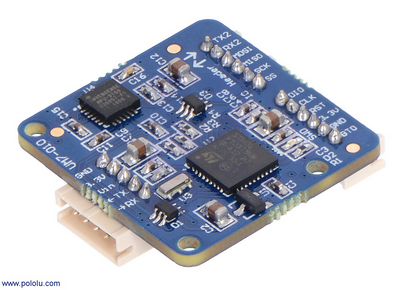
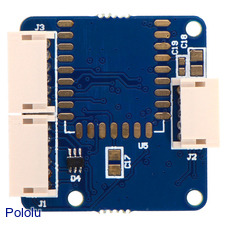 |
| UM7-LT orientation sensor, bottom view. |
|
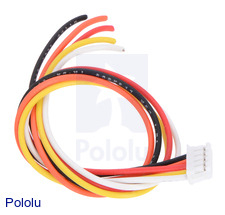 |
| Cable included with the UM7-LT orientation sensor. |
|
Product Comparison
We carry several inertial measurement and orientation sensors. The table below compares their capabilities:
Features
Sensors and processing
- Excellent gyro bias stability over temperature
- Adjustable low-pass filter and EKF settings provide customizable performance for various applications
- States and sensor data synchronized to GPS position and velocity using optional external GPS module
- Allows for alignment calibration and third-order bias and scale factor temperature compensation for accelerometers, gyros, and magnetometer
- Magnetometer soft and hard-iron calibration can be performed through the CHR serial interface software
Communication
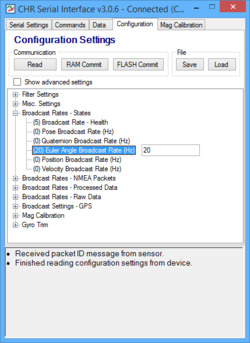 |
| CHR Serial Interface. |
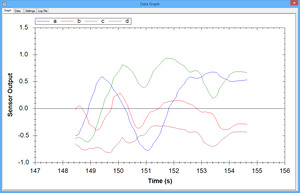 |
| Graph of quaternions displayed by the CHR Serial Interface connected to a UM7-LT orientation sensor. |
- Output data:
- Attitude and heading (Euler angles)
- Attitude quaternion
- magnetometer, accelerometer, gyro data
- GPS altitude, position, velocity (with optional external GPS)
- 3.3V TTL serial interface (UART) with baud rates up to 921,600bps can stream data or provide updates on request
- Note: the main UART pins, TX, and RX, are 5V-tolerant and can be directly connected to 5V systems that are guaranteed to read 3.3V as high
- Transmits data using human-readable NMEA strings (up to 100Hz broadcast), binary packets for higher efficiency (up to 255Hz broadcast), or a combination of both
- Flexible communication architecture allows UM7 to transmit any combination of data at individually adjustable rates
- Connects to the CHR Serial Interface software to allow for real-time plotting of sensor data, logging, device configuration, and magnetometer calibration
- SPI interface available through expansion connector
Specifications
- Dimensions: 1.06″×1.02″×0.26″ (27mm×26mm×6.5mm)
- Weight: 0.12oz (3.5g) without cable
- Operating voltage: 4V to 5.5V
- I/O logic level: 3.3V (with 5V-tolerant main UART pins, TX and RX)
Attitude and heading
- EKF estimation rate: 500Hz
- ±1° typical static pitch/roll accuracy
- ±3° typical dynamic pitch/roll accuracy
- ±3° typical static yaw accuracy
- ±5° typical dynamic yaw accuracy
- 0.5° angle repeatability
- 0.01° angular resolution
Dimensions
| Size: |
1.06″ × 1.02″ × 0.26″ |
| Weight: |
3.5 g1 |
General specifications
| Interface: |
TTL serial, SPI |
| Minimum operating voltage: |
4 V |
| Maximum operating voltage: |
5.5 V |
| Maximum logic voltage: |
3.3 V2 |
| Axes: |
pitch (x), roll (y), and yaw (z) |
| Measurement range: |
±2000°/s (gyro)
±8 g (accelerometer)
±12 gauss (magnetometer) |
| Supply current: |
50 mA |
Notes:
- 1
- Without included cable; 6g with cable.
- 2
- Note: The main UART pins, TX and RX, are 5V-tolerant and can be used directly with 5V systems that are guaranteed to read 3.3V as high. The secondary UART and some of the SPI pins are NOT 5V-tolerant.
File downloads
- UM7 datasheet (2MB pdf)
- Datasheet for the CH Robotics UM7 orientation sensor, revision 1.1 (released June 26, 2014).
Recommended links
- CH Robotics Serial Interface v3.0.7
-
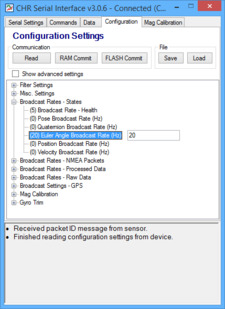 |
| CHR Serial Interface. |
|
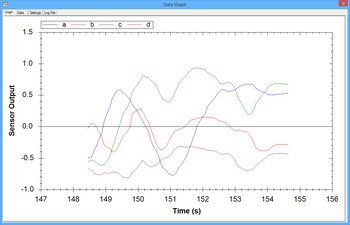 |
| Graph of quaternions displayed by the CHR Serial Interface connected to a UM7-LT orientation sensor. |
|
(This software is open-source; CH Robotics will provide the source code upon request.)
- CH Robotics UM7-LT orientation sensor product page
- Additional information and resources for the UM7-LT orientation sensor can be found on its product page on the CH Robotics website.
- CH Robotics reference library
- The CH Robotics content library provides some background on how their orientation sensors work, including the principles and mathematics behind their operation.
No recommended products at the moment.
No recommended products at the moment.